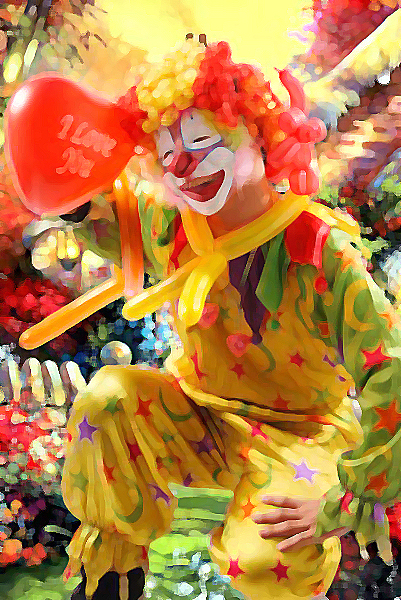![]()

 |
 |
 |
 |
 |
Clowns: Ambassador
of happiness
By Shirley Cheong

Smiley face, colorful gown, big red nose and tall
hat. They do juggling and miming, making everyone laughs. They are welcomed by
people of all ages. In the public, they are representatives of happiness; we
call them “clowns”.
To make people happy
Tommy Ho, 25, has worked as a part-time clown for the past four years, apart
from being a full-time balloon teacher. He gave himself a stage name, Fu-Fu.
Juggling, miming and doing magic are his most requested routines.
What made Ho become a clown? He said, "In 2009, I was making balloon
animals for kids. The kids’ laughter and enjoyment gave me a special
feeling." He was hit upon by the idea of being a clown and spreading
happiness around from that moment.
When asked to share about the hardship he experienced, Ho laughed and said,
“The most difficult thing to do is being able to ‘forget [who you truly are]’
during performances.” Every time he is in a clown gown, a new identity is
created, he is not himself. .
As time passed, Ho noticed a change in his personality. Years of clowning have
made this shy man more open and sociable.
Cheekiness and patience
Clowning is not easy, as Ho introduced, which has a lot to do with interaction
and performance. “Juggling requires a lot of skills, and normally failure is
never accepted,” said Ho. “Whereas, in case there is failure, our job is to
turn it into a part of the performance.” He added that clowns also need a good
sense of humor to interact with their audience.
“To be a professional clown,” Ho said, “you must have some basic skills:
balloon artistry, miming, or even makeup application.” Moreover, he highlighted
the importance of clowns’ psychological quality: great patience and endurance,
since their target audience is mostly children.
Behind the make-up, Ho’s role is more than just a clown, but also a teacher, a
brother and a friend. “In one of my performances, I saw a kid behave badly and
was rude to other kids,” he said. “I was a clown and I could not get mad at
him. Instead, I used another approach -- to reward him for his good behavior.
Thus he behaved so differently for the rest of time.”
After all, the clowns’ mission is to draw people’s attention and make them
laugh. However, Ho found it more challenging to get their attention today.
“Thanks to the advancement of new technology, kids pay no more attention to my
performance, they only look at their tablets now!” he said.
More than money
“Clowns receive more recognition nowadays. People invite us to perform in
events, birthday parties, wedding parties, etc. The demand for clowns is
increasing in recent years,” said Ho. He added that there would be regular
shows every month, and 10 to 12 performances during Christmas. The period
between October and February is usually the peak season. He could receive up to
MOP 1,200 or 1,500 for a one-hour show.
“For me, clowning is more about cheering others and myself. I enjoy the time
being a clown, I do consider making it as my full-time job in the future,” Ho
said. “I have to make a living, yet doing what I love is even more essential.”
He encouraged aspiring clowns to learn this art seriously, keep passion, and
not to forget who you are and what you are for.
Ho shared his motto “Don’t give up as great things take time” at the end of the
interview. He said, “Stay positive to the unsupportive feedback towards you,
prove to them you are doing meaningful things and making the world a happier
place to live in!”